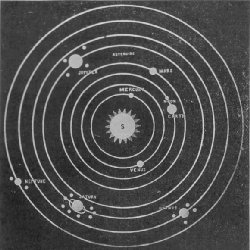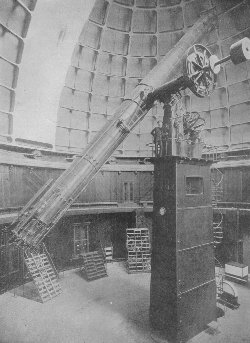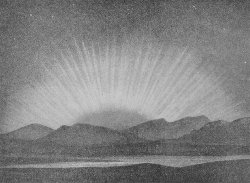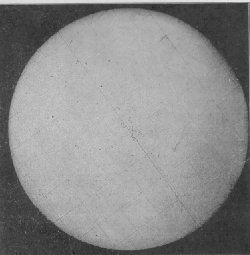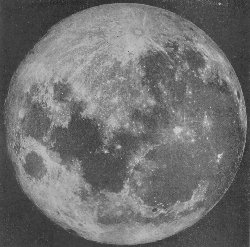Most startling of the things to consider in the study of the starry sky is its immeasurable space. The earth, we know, is only one seemingly infinitesimal speck in the harmony of the universe. Millions upon millions of stars are traveling throughout space in some direction. Our solar system with its sun for a center, and its planets, stars and satellites, is not the only one thus in motion. These systems, like the sun's, seem shooting off wildly into space, but who knows whether, centuries upon centuries from now, these seemingly wild flights may not shape themselves into orbits, similar to that of the earth. Perhaps, in the end of all things, these worlds that go careering along in space may all unite, gathering size as they go, and eventually all burning up and leaving a black and starless sky. When we know that the stellar bodies are traveling in all directions, some of them at the frightful speed of 200 miles a second, we wonder what will be the outcome. We are amazed at the immensity of space. One well known astronomer has used a very clever illustration to indicate the size of the universe. He describes all known space as about the size of the United States. Upon this he lays an ordinary lady's finger ring, as the comparative extent of the earth's orbit. An actual mile away from the ring, he states as the comparative distance of the first fixed star. The constellation of Lyra is about ten miles from the ring, flying along at the rate of three hundred million miles a year, and all the space from the Atlantic ocean to the Mississippi river is filled with constellations, stars and planets. What wonder that even the mind of the scientist is awe-stricken. While we are wondering at the immensity of the universe, we are carried along into other problems which as yet the scientists have not solved. We know that friction causes heat. We see this in the combustion of the shooting stars, which we know do not start out on their journeys already on fire, but are heated and burned up because of the friction of the atmosphere, as they tear along through the skies. If we can see this in the few stars that shoot to earth, how many are there that we do not see, and what immense heat is derived from this great friction of the stellar bodies? We know or think we know that such glowing bodies as the sun are combustible, because of the contraction of their parts by gravitation. Perhaps all bodies are contracting and throwing off some heat. Where then does all the heat go? What becomes of the light also that has flown from the myriads of stars since the creation? We know that light flies at the rate of 180,000 miles a second. Can it be possible that in the millions of years since the earth began its formation, the light that first went off from the first sun has not reached the confines of space? If these questions perplex us, what are we to say of the stars and planets which we can see with the naked eye? Is Mars inhabited? Does Venus have an atmosphere like that of our earth? What of the moon, so close to us that we think we can distinguish craters of worn-out volcanoes, and the dry beds of old rivers and oceans? What of the spots on the sun, what causes them, what is the corona about this body, and why does the sun seem so calm when it is a raging furnace?
Then came Kepler, who adopted the Copernican theory, and whose observations upon the planet Mars cleared away many complications. He also remarked that gravity was a power existing between all bodies, and reasoned upon the tides being caused by the attraction of the moon for the waters. About this time, namely, the beginning of the seventeenth century, the telescope was invented and logarithms came into use. Galileo, who had discovered the laws of the pendulum and of falling bodies, learned that a Dutch watchmaker had invented a contrivance for making distant objects appear near. With his profound knowledge of optics and philosophical instruments, he instantly caught the idea, and soon had a telescope made that would enlarge things 30 times. With this telescope he looked at the Moon, discovered its valleys and mountains, and watched the heavy shadows sweep over its plains. Near Jupiter he saw three bright stars, as he considered them, which were invisible to the naked eye. Shortly after, he noticed those stars had changed their relative positions. Somewhat perplexed, be waited three days for a fair night in which to resume his observations. When he looked again the stars had shifted. After much observation be discovered a fourth star, and finally found that they were all rapidly revolving around Jupiter, each in its elliptical orbit, with its own rate of motion, and all accompanying the planet in its journey around the sun. Here was a miniature Copernican system hung up in the sky for all to observe for themselves. Galileo met with the most bitter opposition. A great many refused to look through the telescope, lest they might become the victims of the philosopher's magic. Some prated of the wickedness of digging out valleys in the fair face of the moon. while others doggedly clung to the theory they had held from their youth up. Then Newton promulgated his immortal discovery of the law of gravitation. Subsequent researches brought astronomy into prominence more and more. The spectroscope has revealed elements existing in the vapors and compositions of the sun and of the heavenly bodies. Stars are now known to be suns, some bearing a great resemblance to our sun, and others differing materially. Instruments for astronomical observation have now been brought to a pitch of perfection scarcely ever dreamed of, and month by month discoveries are made and recorded, while calculations as to certain combinations can be made with almost miraculous accuracy. The transit of Venus, the approaches of comets, eclipses, and the movements of stars are now known precisely, and commented on long before the events can take place.
With this remarkable instrument, it has been learned that a layer of carbon surrounds the sun, a thing hitherto unknown. By means of spider-webs drawn across the eye-piece of this instrument, the fifth satellite has been measured. Very good photographs of the moon have been made, and it has been learned that some of the heat from the stars reaches the earth. The workings of the telescope are very interesting. In making measurements of stars, spider-webs are used. Spiders are kept for the purpose of spinning threads and the webs are strung in boxes arranged like lantern slides across the eye-piece. Distances have already been computed between the stars. Knowing the distance between the web and the stars, when the shadow of the star appears upon the webs, the size of the former can be ascertained. These webs are also used to catch the lights and colors of the stars, so that astronomers, knowing that certain minerals burn with a certain color, may classify the makeup of the stars. The telescope is arranged very aptly for taking photographs. A light shutter is placed at the end nearest the sky, and the photographic plate is put at the eye-piece. THE SOLAR SYSTEM. The solar system consists of the sun, the center; the major planets, Vulcan (undetermined), Mercury, Venus, the Earth, Mars, Jupiter, Saturn, Uranus, Neptune, the asteroids, or minor planets, the satellites or moons, which revolve around the several planets; meteors, shooting stars and comets. The stars called planets have certain motions, going from East to West, from West to East, and sometimes again appearing quite motionless. This change of place from one side of the sun to another, has given them their title of "wanderers." The planets and their satellites, the asteroids, comets and meteors, all circle around the sun in more or less regular orbits. There must also be families of comets that have not yet appeared to us, and whole systems of meteors as yet unseen. The sun is not solid, so far as we can tell. It is apparently a mass of white, hot vapor, and is enabled to shine by reason of its own light, which the planets and stars cannot do. They shine only by the sun's reflected light. We might therefore conclude that the sun is all gas, but through recent study by the spectrum, scientists have discovered that a number of elements exist in the sun in a vaporous state. Hydrogen is there, with other gases unknown to us, and many metals. The sun is supposed to be spherical in shape, not flattened at the poles as our earth is, and to be composed of materials similar to those which constitute the earth, only that in the sun these materials are still in a heated condition. The sun's average distance from the earth is 91,500,000 miles. The volume of the sun is 1,253,000 times that of the earth but its density is only about one-fourth that of the earth. The attraction of gravitation at the sun must be 27 times more than that of the earth's surface. A body dropped near the surface of the sun would fall 436 feet in the first second, and would then attain a velocity of ten miles a minute.
The ancients knew five of the planets, and named them Mercury, Venus, Mars, Jupiter and Saturn. In later years a great number were discovered, but the principal ones are eight in number, including our own earth, Uranus and Neptune. All the planets are spheroids and vary greatly in size. Comparing their size and magnitude, Sir John Herschel said: "Choose any well-leveled field, and on it place a globe two feet in diameter to represent the sun. Mercury will be represented by a grain of mustard seed on the circumference, with an orbit 164 feet in diameter; Venus is represented by a pen, in a circle 284 feet in diameter; the earth also by a pea, in a circle of 430 feet; Mars., a rather large pin's head, in a circle of 654 feet; Juno, Ceres, Vesta and Pallas (asteriods), grains of sand in orbits of 1,000 to 1,200 feet; Jupiter, a moderate sized orange, in a circle nearly half a mile across; Saturn, a small orange, in a circle four-fifths of a mile across, and Uranus, a full-sized cherry, or small plum, upon the circumference, more than a mile and a half in diameter." The distance of Mercury from the sun is less than half that of our earth, and so it receives much more heat and light than do we. The sun viewed from that planet, if such a thing were possible, would appear seven times larger than from the earth. Mercury's orbit is the most eccentric of any of the eight principal planets, so that, although when in perihelion it approaches to within 28,000,000 miles, in aphelion, it speeds away 15,000,000 miles further, or to the distance of 43,000,000 miles. Being so near the sun, its motion in its orbit is correspondingly rapid—30 miles a second.
It seems rather strange to class our earth, which is dark and opaque, and which appears to us so vast, among the bright heavenly bodies. Nevertheless, it is one of the smallest of the principal planets of the solar system, and although we see in it no motion, while the orbs about us seem constantly changing their positions, science has shown that the earth revolves around the sun in an orbit of nearly 600,000,000 miles, at the tremendous rate of 18 miles a second, or 65,000 miles an hour. To other worlds our earth appears as a star does to us. In studying astronomy we must consider that it is a planet shining brightly in the heavens, held in its course by the invisible power of gravitation, and that in reality it is small and insignificant beside some of the mighty spheres that so gently shine upon us from distances almost inconceivable. Our earth, in fact, is only one atom in a universe of worlds, all firm and solid, and all, perhaps, equally well fitted to be the abode of human beings and animals. The moon is the satellite of the earth. "Fancy," says Lockyer, "a world without ice, cloud, rain or snow; without rivers or streams, and therefore, without vegetation to support animal life; a world without twilight, or any gradations between the fiercest sunshine and the blackest night; a world also without sound, for, as sound is carried by the air, the highest mountain on the airless moon might be riven by an earthquake inaudibly."
There are eclipses of the sun and of the moon. The former occur at the time of the new moon and the latter at full moon. This can be understood readily when we remember that the sun is eclipsed by the moon passing between us and the sun. The moon is eclipsed because the shadow of the earth falls upon her when it is opposite the sun and therefore "full." The ebb and flow of tidal water depend upon the moon to a great extent. Twice every day we have the tides, twelve hours apart, and the flow and ebb are merely examples of the attraction of gravitation, which is exercised on all bodies, whether liquid or solid. Mars appears to the naked eye as a bright red star, rarely scintillating and shining with a stedy light which distinguishes it from the fixed stars. Its ruddy appearance has led to its being celebrated among all nations. The Jews called it "blazing," and it bore in other languages a similar name. The orbit of this planet is exterior to the earth's, as is proved by it never appearing "horned" nor ever passing across the sun's disk. Therefore, no transits of Mars can take place as do transits of Venus and Mercury. Mars is most like the earth of all the planets. There appears to be a white or snowy region near its poles at varying periods, which would lead us to the conclusion that the changes of atmosphere and the seasons are similar to our own; and as the inclination of the planet is nearly the same as that of the earth, this supposition may be accepted as a fact. Mars is attended by two satellites, or moons, discovered in 1877, both very small. Jupiter is called the giant planet, and is 1,300 times larger than the earth. Its mean diameter is 86,500 miles, with 270,000 miles circumference. Its inclination is very small, and therefore the changes of seasons are very slight. It has four satellites. These moons act, with respect to Jupiter, very much as the latter acts with respect to the sun. Jupiter is the largest of the planets, and only Venus is brighter. It revolves at a distance of 476,000,000 miles from the sun and 390,000,000 miles from the earth., and its year is equal to nearly twelve of ours, while its day is scarcely ten hours long, showing a rapidity of motion more than 20 times that of the earth. There is much less sunlight and heat on Jupiter than upon the earth, because it is so much farther away from the sun. There is but little difference in the length of the days and nights there, which are each of about five hours' duration. At the poles, the sun is visible for nearly six years, and then remains set for the same period. Saturn is a great globe surrounded by a beautiful bright ring or series of rings, and attended by eight satellites. It appears to have much the same constitution as Jupiter, but is enveloped in an atmosphere even denser. It revolves on an inclined axis and has seasons unequal in length. The rings of this planet are apparently broad, flat and thin, resembling roughly the horizon of the globe, and are supposed to be a close agglomeration of stars or satellites, revolving around the planet and encircling it in a belt. The two outermost rings are very bright, the inner ring being darker and partially transparent, for the ball of Saturn can be perceived through it. Saturn, on account of its distance, shines with a feeble, pale, yellow light, which is steady and distinguishes it from the fixed stars. Its orbit is so vast that its movements among the constellations may be traced readily through one's lifetime. It takes two years and a half to pass. through a single sign of the zodiac; hence when once known, it may be found easily again. As the earth and Saturn occupy, different portions of their orbit, the distances between them at different times may vary 200,000,000 miles. Uranus was discovered by Herschel in 1781. It revolves at an enormous distance from the sun, namely, 1,753,000,000 miles. It takes about 84 of our years to go around the sun, and it possesses four moons. It is about four times larger than the earth in diameter, and about 40 times in volume. We, can only speculate concerning its physical constitution, which is assumed to be similar to that of Jupiter, while the changes of temperature and seasons must vary immensely. Neptune is the far-off sentinel at the very outposts of the solar system. The existence of this planet was determined by calculation before it had been seen at all. Uranus was observed to be disturbed in its orbit, moving sometimes faster than at other times, and even before Uranus had been discovered, Saturn and Jupiter had been seen to be affected by some other body in the system. Very little can be said concerning this planet, as its distance is too great for good observation. It has one moon, which moves about the planet in five days and 21 hours, and is of great size. The asteroids are smaller planets circulating outside the orbit of Mars. They are all at distances from the sun ranging between 200,000,000 and 300,000,000 miles, the periods of sidereal revolution ranging from 1,100 to 3,000 days. Consequently their years are from three to nine times as long as ours. Nearly 250 of these minor planets have been discovered. They are all very much smaller than the earth. Meteors are small, erratic bodies, rushing through the planetary system and getting hot in the process. They appear in the atmosphere surrounding our earth as "shooting stars." Some of these falling bodies have reached the earth. Such are called aörolites, or meteorites. Numbers, of course, are burned up before they reach us. They are of a metallic nature. On certain nights of August and November it has been calculated that these meteors will appear. They fall from certain constellations, after which they are named., as Leonidas, from Leo, in the November displays. The star showers sometimes present the appearance of a beautiful display of rockets. Millions of them rush around the sun. It has been lately suggested that there is a great degree of affinity between comets and meteors, in fact, that a comet is merely an aggregation of meteors. Comets have been supposed to be bodies of burning gas. Their mass is very great and their brilliant tails are many millions of miles in extent. In their orbits they differ greatly from the planets. While the latter are direct in their wanderings, comets are more irregular and eccentric. When first seen, the cornet resembles a faint spot of light upon the dark background of the sky. As it comes nearer, the brightness increases and the tail begins to show itself. The term comet signifies a hairy body. A comet consists usually of three parts, the nucleus, a bright point in the center of the head, the coma, a cloud-like mass surounding the nucleus, and the tail, which is a luminous train extending generally in a direction from the sun. It is not understood whether comets shine by their own or by reflected light. The fixed stars are those which apparently remain immovable and shine with a shifting, twinkling light, although it is known now that they also are in motion. The number of the stars is beyond our calculation. Those visible only in the telescope amount to millions. The stars visible to the unaided eye are about 6,000, in number. There are more visible in the southern than in the northern hemispheres. The nebular hypothesis was put forward by Laplace, and by it he attempted to account for the stellar system, which is supposed to have originated from an immense nebular cloud. This immense mass would rotate and contract and the outer portions would separate and develop into rings, like Saturn's rings. Then the rings would break into separate portions, each portion condensing into a planet, or the small "bits" would travel around the sun like asteroids, and in this manner various systems would be formed. The "milky way" is a whitish, vapory-looking belt, and is composed of multitudes of millions of suns, of which our own sun, itself, is one. They are so far removed from us that their light mingles and makes only a fleecy whiteness. An actual knowledge of the milky way is still beyond us. It is agreed, however, that the galaxy is not a continuous stream, but a series of luminous patches, great aggregations of stars illimitable in numbers, and independent of each other. LABOR UNIONS AND ARBITRATION |

